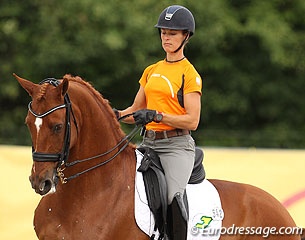
More and more internationally competed dressage horses ate getting diagnosed with heart murmur or cardiac arrhythmia. Adelinde Cornelissen's Parzival first drew major attention to the illness and afterwards more cases followed:
Australian Grand Prix rider Kelly Layne's Udon P, Belgian young rider Eline de Coninck's Don Warohn and British GP rider Stephanie Croxford's retired Mr President. Time to look into the matter a bit more closely.
Prof. Gunther van Loon, specialist in Equine Heart research, says that heart murmurs and arrythmias are a very broad topic, and while the two are different they are related
“We can write a book on that," Gunther told Eurodressage. “Murmurs and arrhythmias are common in horses, are a frequent reason for further cardiac examination, and are often well tolerated for prolonged periods of time depending on severity."
Heart Murmur vs Arrhythmia
A murmur, according to Gunther, is best explained as a valve that does not function properly; occasionally due to an abnormal, congenital, communication in the heart. The "leaking valve" produces a sound, audible with a stethoscope, called a ‘murmur’. Ultrasonography is used to determine the importance of a murmur.
Arrhythmias, on the other hand, are abnormalities in the cardiac rhythm, as the normal rhythm should be regular. Arrhythmias can be heard with a stethoscope if it is present at rest, and final diagnosis is with an electrocardiogram recording, at rest and also during exercise.
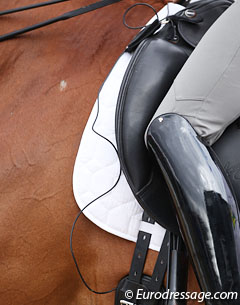 The two are both important and related, as a murmur can lead to an arrhythmia. “Some murmurs gradually progress and gradually develop an impact on performance or, importantly, can give rise to arrhythmias," said Van Loon. "Some arrhythmias impair performance or can even be dangerous for collapse or sudden death.”
The two are both important and related, as a murmur can lead to an arrhythmia. “Some murmurs gradually progress and gradually develop an impact on performance or, importantly, can give rise to arrhythmias," said Van Loon. "Some arrhythmias impair performance or can even be dangerous for collapse or sudden death.”
The risk involved, Gunther points out, depends on the type of murmur and the degree of severity. “Cardiac exam and identifying the exact cause of the murmur are therefore important to assess if there is an increased risk or not. The same goes for arrhythmias," Van Loon explained.
While there are certain types of therapies available for many arrhythmias, generally murmurs cannot be cured. “A number of arrhythmias can be cured by medication. Atrial fibrillation, a specific form of arrhythmia, can also be cured by electrical shock therapy under general anaesthesia.”
What Causes Heart Murmur?
While Gunther advises that some valvular problems are age related, there is currently no real proof that heart conditions of this sort are passed onto offspring, with the rare exception of some defects/communications in the heart of which some horses might carry a hereditary factor.
Veterinarian Dr. Alessandro Centinaio adds that murmurs have been attributed to the presence of turbulent blood flow, periodic wake fluctuations or to eddy-and vortex-formation causing vibration of solid structures. “Murmurs can be associated with congenital cardiac abnormalities, and often develop as a result of valvular dysfunction,but they are also present in a large number of clinically normal horses,” says Centinaio. “Loud cardiac murmurs are frequently identified in horses with colic that subsequently disappear when the gastrointestinal signs resolve. Currently, the causes of such murmurs remain unclear. "
Centinaio lists other causes of murmurs in horses including aortic regurgitation aortocardiac fistula, mitral regurgitation, tricuspid regurgitation, truncus arteriosus, ventricular septal defect and finally valvular regurgitation.
Valvular regurgitation is an important cause of murmurs in horses, second only to physiological flow murmurs in prevalence. It occurs both in the presence and absence of valvular pathology. Valvular lesions can be congenital, degenerative, inflammatory or idiopathic in nature.
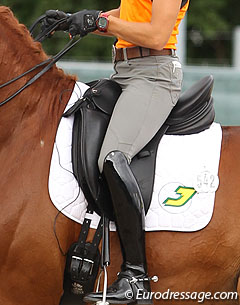 The aortic insufficiency murmur is caused by the development of an irregular edge to the aortic valve. The murmur is thought to be an "old-age" change and generally does not cause a physical problem. The murmur can be soft or very loud, but the intensity poorly reflects severity of valve insufficiency. The major concern related to aortic insufficiency is whether or not the horse develops ventricular arrhythmias during exercise, which can be regarded as an increased risk for collapse. The heart should therefore be evaluated thoroughly at rest but also during exercise to ensure that there are no arrhythmia other problems.
The aortic insufficiency murmur is caused by the development of an irregular edge to the aortic valve. The murmur is thought to be an "old-age" change and generally does not cause a physical problem. The murmur can be soft or very loud, but the intensity poorly reflects severity of valve insufficiency. The major concern related to aortic insufficiency is whether or not the horse develops ventricular arrhythmias during exercise, which can be regarded as an increased risk for collapse. The heart should therefore be evaluated thoroughly at rest but also during exercise to ensure that there are no arrhythmia other problems.
Another important murmur in horses is a mitral insufficiency murmur. The mitral valve is the valve between the left atria and left ventricle and slams closed when the left ventricle contracts, moving oxygenated blood out of the aorta and to the body. The signs of acute mitral valve rupture are extreme exercise intolerance (many pull up while working and are extremely prostrate), collapsing, tremors, high heart rate, rapid breathing, blue gums, colic, and/or death.
"A more chronic mitral valve murmur might have no clinical signs or just exercise intolerance. The aortic insufficiency and mitral insufficiency murmurs are two of the relatively common heart murmurs that horses develop, but there are others that can develop that are caused by turbulence of blood flow within the heart for a variety of reasons," Centinaio explained.
The management of murmurs depends on the pathology. "If the pathology can’t be cured and it is life-threatening, the horse should stop training and working," Centinaio added.
For some idea as to how common murmurs are in the equine world, Centinaio stated that murmurs of mitral regurgitation are present in around 2.9–3.5% of the otherwise healthy, general horse population. “In racing Thoroughbreds the prevalence is much higher and it is at its highest in horses competing over jumps (19% of hurdlers and 23% of steeplechasers) compared to 7– 18% of various groups of Thoroughbreds successfully engaged in flat racing," he said. "Recent data have shown that the presence of multivalvular regurgitation increases in response to age and athletic training in Thoroughbreds and Standardbred racehorses.”
Murmur and Arrhythmia in Dressage Horses
The Ups and Downs of Don Warohn
Belgian Young Rider Eline de Coninck-Borrey says her 14-year old Oldenburger Don Warohn (by Dormello) already had murmurs when he was young, but had outgrown them when she started on him.
“In 2010 he got endocarditis, probably caused by an infection of his teeth and the bacteria came into the blood. In 2010 I could see very clearly that he was ill. He had fever and was very tired, not like he is usually. He recovered but because of scar tissue on a heart valve we could hear murmur on the right side of his heart.”
Don Warohn returned to sport and everything was absolutely normal, but she had the horse checked on a regular basis.
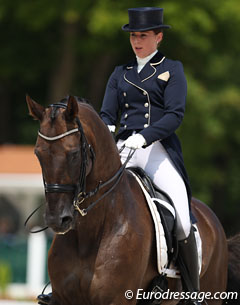 “Unfortunately in October 2013 we detected bigger murmurs when the dentist came and he wanted to anaesthetise him to do the teeth," De Coninck explained. "I told him that if he would listen at the right side he would hear a murmur. He told me that he also could hear a murmur on the left. By chance the vet was there and I asked him if he could listen. He told me to go to the heart specialist immediately. At that moment he had many extrasystoles, 540 in one hour.
“Unfortunately in October 2013 we detected bigger murmurs when the dentist came and he wanted to anaesthetise him to do the teeth," De Coninck explained. "I told him that if he would listen at the right side he would hear a murmur. He told me that he also could hear a murmur on the left. By chance the vet was there and I asked him if he could listen. He told me to go to the heart specialist immediately. At that moment he had many extrasystoles, 540 in one hour.
Eline took her liver chestnut gelding to Prof. Gunther van Loon who told her that the extrasystoles were dangerous because the horse could collapse from them. Don Warohn was immediately given stall rest and cortisone, because the heart specialist wanted to be sure that there was no inflammation nor disease causing those extrasystoles.
"After those cortisones he still got extrasystoles and so we started to test in which situation he had more of them," Eline reminisced. "We found that they were caused by stress and when he had no stress he almost had no extrasystoles."
Creating a stress free environment and finding doping free relaxation supplements were a challenge. It took Eline more than half a year to set up the right management system.
"We had to find a doping free supplement that could reduce stress but still would allow him to perform. We found the right supplement and seven months later we could bring him back in training. The heart specialist checked him every 3 months and we did an ECG before every competition to be sure everything was still ok.”
De Coninck was able to make a come back to the show ring, but it did not last very long. In October 2014 she felt her horse losing some fitness and after 10 minutes he was sweating and became anxious.
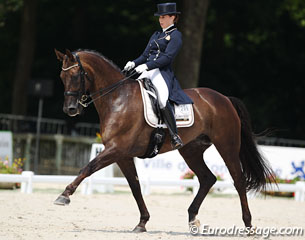 “He always had problems with the change of the seasons so I thought the sweating was caused by muscle acidification so the vet did anotherblood test. The results wereperfect; in fact he had one of his best blood results in a long time. I still rode him and one day in November I halted during training. He was shaking very heavily and sweat was dripping off. I asked the heart specialist for a check-up and told him about the blood result and about the shaking. After another ECG the heart specialist told me that Don Warohn now had atrial fibrillation. Because he already had extrasystoles he had a bigger chance to get atrial fibrillation but it was just bad luck that he got that. At the Ghent Equine Universisty, Don Warohn’s normal cardiac rhythm was restored by electrical shock therapy under anaesthesia. Right now he is in very light training and we check him every four to five weeks.”
“He always had problems with the change of the seasons so I thought the sweating was caused by muscle acidification so the vet did anotherblood test. The results wereperfect; in fact he had one of his best blood results in a long time. I still rode him and one day in November I halted during training. He was shaking very heavily and sweat was dripping off. I asked the heart specialist for a check-up and told him about the blood result and about the shaking. After another ECG the heart specialist told me that Don Warohn now had atrial fibrillation. Because he already had extrasystoles he had a bigger chance to get atrial fibrillation but it was just bad luck that he got that. At the Ghent Equine Universisty, Don Warohn’s normal cardiac rhythm was restored by electrical shock therapy under anaesthesia. Right now he is in very light training and we check him every four to five weeks.”
Atrial fibrillation is an arrhythmia which affects the normal regular electrical impulses generated by the sinoatrial node in the right atrium of the heart. They are overwhelmed by disorganized electrical impulses usually originating in the roots of the pulmonary veins. This leads to irregular conduction of ventricular impulses that generate the heartbeat.
De Conick-Borrey had to deal with a double whammy when her 6-year old Belgian warmblood Jackson was also diagnosed with a heart murmur. Her daily attitude towards training has changed, not only for the horses she knows have murmur but towards all of her horses.
" I have the vet come more often, when I listen to the heart of Warohn and Jackson, I also listen to the heart of the other horses. When a horse suddenly has a loss of condition I will get them checked quicker. With Jackson I can work normal but with Warohn I have to be honest that there is always a certain concern when I work with him. Sometimes I listen to his heart for 10 minutes to be sure if I really can't hear a change. It is hard when you hear that your horse has murmurs, but it was a great lesson for me and in the future I will recognize heart problems sooner or call for a checkup more quickly as I am much more conscious about what can happen to a heart when there is much stress and when the horse has to perform a lot."
Problems of the Heart for Grand Prix horses Udon P and Mr President
Stephanie Croxford’s former Grand Prix horse Mr President developed heart murmur very late on in his career. Steph says they had no idea how the horse developed it and that age factored into their decision to retire him from sport in 2013.
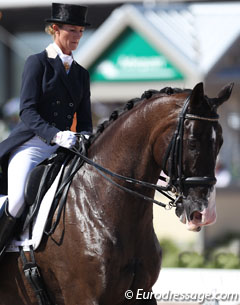 “The heart murmur was detected as part of a usual vet check during his annual vaccinations," Croxford told Eurodressage. "The last time he was checked six months earlier it wasn’t present. The vet said it was so loud she could hear it on the other side of his body.
“The heart murmur was detected as part of a usual vet check during his annual vaccinations," Croxford told Eurodressage. "The last time he was checked six months earlier it wasn’t present. The vet said it was so loud she could hear it on the other side of his body.
The now 21-year old Mr President was retired from international competition in 2013 but was still ridden at home. "As has done at least 12 years of Grand Prix work we decided to finally retire him straight away and stop riding him," said Stephanie. "The vet recommended that we do not ride him unless there was more tests carried out on his heart condition but given his age the best course of action was to retire him completely.”
Australian rider Kelly Layne first noticed her Grand Prix horse Udon P was not quite right in a training session shortly after winning the Grand Prix Freestyle at the 2014 Wellington CDI.
“Udon started coughing about 20 minutes into the session,” Kelly told Eurodressage. “I walked him around for 5 minutes and then tried to trot again and he started acting like he was choking. My mother had given him a spearmint so I quickly walked him back to the stables, calling my vet on the way. They immediately scoped him and found blood in his lungs. They recommended two weeks rest only walking. They scoped him again the day before returning to work and everything was clear.”
Kelly continued her training of Udon, but sadly he was very unwilling to work and would cough 10 minutes into the lesson.
“Training was impossible. Udon is a horse that is never ridden with a whip but at the 20-minute mark I really wanted to pick up a whip - a feeling I had never had in the previous 12 months," she said. "I decided to experiment and after a week I called my vet to see first hand my findings and we began to see that Udon was a Gand Prix horse that could suddenly not make a clean flying change after 20 minutes of work. I said to my vet "can you please come tomorrow and watch me ride the horse again?" The next day I did my normal 15 minutes walk and some trot to loosen up. I then go directly to canter 4's, 3's, 2's 1's no mistakes! Left rein, right rein it did not matter. I take a short break, do some fancy trot work and then after 20 minutes of work I start canter. I went across the diagonal and asked for a single change; he cross-gaited and after three or four attempts at asking the hind leg to change he does it but then I went across the diagonal again and the same thing happens."
This anomaly provoked a call to Dr Meg Miller. The next day she diagnosed Udon with atrial fibrillation. "She said in his case it was easy to miss (his heart had been listened to many times) as he has a very slow heart rate and it was regular for three beats before it disappeared for a few seconds. Udon's resting heart rate is 42 and it rarely gets above 80 during a work session. He recovers very quickly and after 5 minutes walk from full Grand Prix work is below 60.”
Kelly was faced with two options: convert him using drugs but that would mean the end of his international dressage career as he would have to be on the heart medication for life (which is not permitted by the FEI), or to put him on the table at the University of Florida in Gainesville and let them shock his heart back to normal.
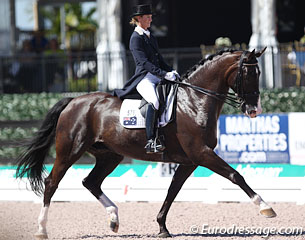 “We were fully aware of the risk and decided to 'give it go’," said Layne. "They told us that some horses go immediately back into A-fib the moment they stand up after the procedure. The first month is also risky for relapse. Taking our time with the rehab, in week six after the conversion, I rode Udon through all the Grand Prix with ease and you can't imagine the smile on our faces.”
“We were fully aware of the risk and decided to 'give it go’," said Layne. "They told us that some horses go immediately back into A-fib the moment they stand up after the procedure. The first month is also risky for relapse. Taking our time with the rehab, in week six after the conversion, I rode Udon through all the Grand Prix with ease and you can't imagine the smile on our faces.”
During the rehabilitation to full fitness Udon's diet was supplemented with vitamin C and the low sodium (alternative salt - potassium) instead of regular sodium. Kelly says some experts believe that it may be an electrolyte imbalance that can cause the heart to flip into A-Fib.
“The other more common reason is that the heart rate increased suddenly to more than 200 beats per minute; more common in racehorses and eventers. Udon's heart converted at 175 joules. They inserted a wire through the neck and pushed it down until it wrapped around the heart and then on the third attempt he converted into normal sinus rhythm.”
Kelly admits that putting this out of her mind was difficult and it wasn't until they went to the Devon Horse show in September 2014, that she finally got over it.
“I remember in the warm up for the Grand Prix in September thinking "Oh my god this is a big stadium this could be too much for him," so I babied him around the test and nothing happened. The next night for the Freestyle in front of a fully packed stadium I knew if I didn't push Udon we were not getting around. The more I pushed the better he felt and as I was riding the test many of my fears melted away. My husband still checks his heart all the time and I am so glad he does so I don't obsess about it. I try to put it out of my mind but cherish everyday I get to ride this sensitive and generous horse."
Kelly has changed the music of her freestyle around and made it a "heart-felt" dedication to the struggles they've overcome.
"We are so thankful that we decided to dedicate our new freestyle to all songs about the heart as a celebration to his return to the international dressage arena," she stated.
by Sarah Warne for Eurodressage - Photos © Astrid Appels
Related Links
Kelly Layne's Udon P Diagnosed with Cardiac Arrhythmia
Adelinde Cornelissen's Parzival Diagnosed with Arrhythmia
Oldenburg Grand Prix Stallion Rubinrot Passed Away